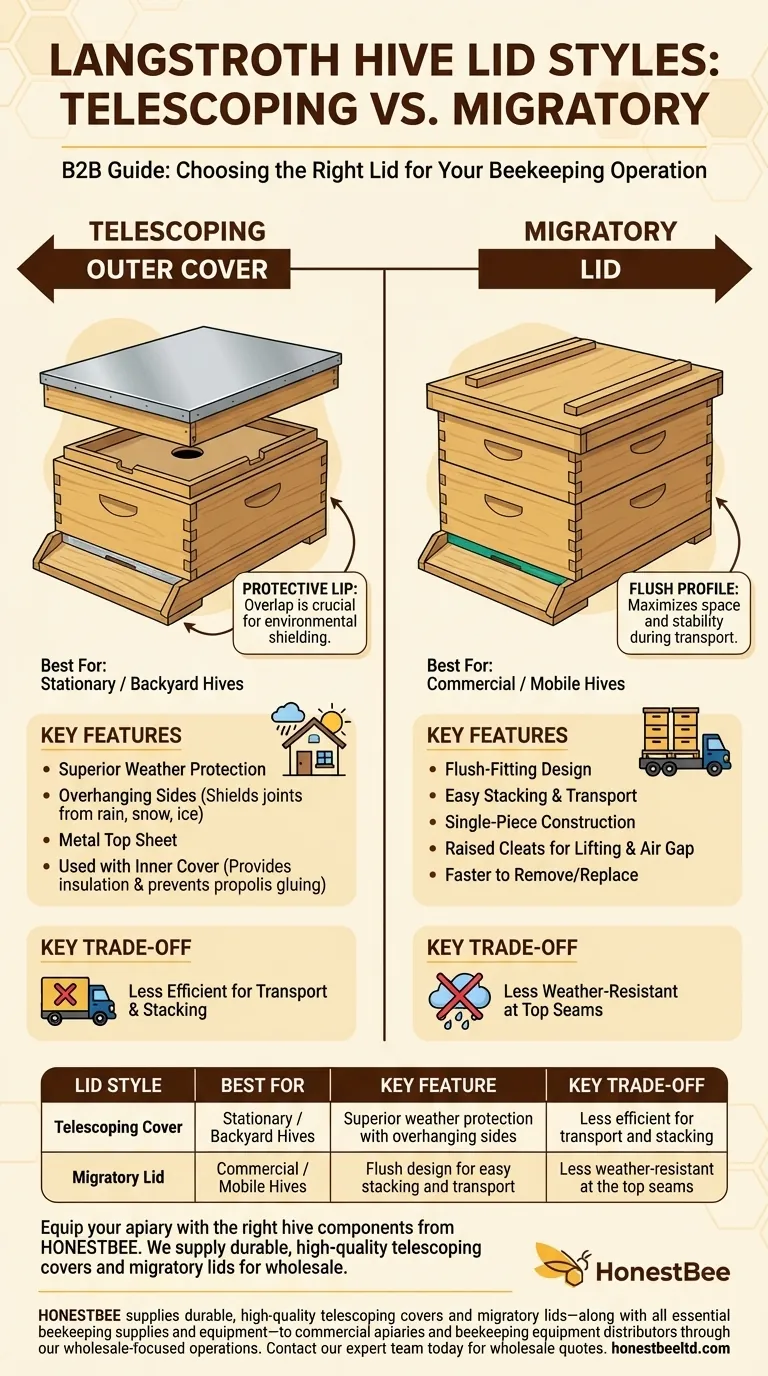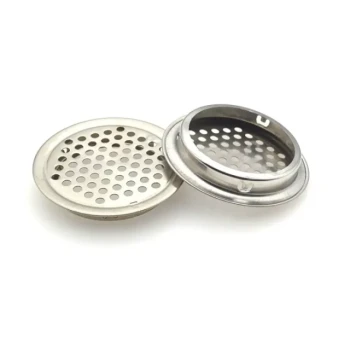In beekeeping, the two primary lid styles for a standard Langstroth hive are the telescoping outer cover and the migratory lid. While both serve the fundamental purpose of protecting the hive from the elements, they are designed for distinctly different beekeeping philosophies and operational needs.
The core difference comes down to a simple trade-off: The telescoping cover offers maximum environmental protection for stationary hives, while the migratory lid prioritizes efficiency and transportability for hives that are moved frequently.

Understanding the Telescoping Outer Cover
A telescoping cover is the most common choice for backyard and hobbyist beekeepers. Its name comes from the way it "telescopes" down over the top edges of the uppermost hive body.
Design and Construction
The telescoping cover is a wooden lid with a protective metal sheet on top. Its key feature is the sides, which extend down several inches, creating a lip that overhangs the hive box.
This design is intentionally larger than the hive box itself. This overlap is crucial for its protective function.
The Role of the Inner Cover
A telescoping lid is almost always used with a separate inner cover. This is a flat wooden board with a ventilation hole in the center and a notched rim for an upper entrance.
The inner cover provides a layer of dead air space, which insulates the hive from extreme heat and cold. It also prevents the bees from gluing the outer cover to the hive body with propolis, making inspections much easier.
Primary Advantage: Weather Protection
The telescoping design is superior for shielding the hive. The overhanging sides protect the hive's joints from rain, snow, and ice, preventing water from seeping into the hive and promoting the longevity of the wooden components.
Understanding the Migratory Lid
The migratory lid is the standard for commercial beekeeping operations, where hives are frequently transported for pollination services.
Design and Construction
This lid is a much simpler, single-piece cover. It is a flat, sturdy wooden lid constructed to sit flush with the outer dimensions of the hive body.
It lacks the overhanging sides of the telescoping cover. Often, it has raised cleats on the top surface to facilitate lifting and provide a small air gap when hives are stacked.
Primary Advantage: Efficiency and Portability
The flush-fitting design is the migratory lid's greatest asset. It allows hives to be stacked tightly next to and on top of each other on pallets and trucks, maximizing space and stability during transport.
This design is also faster to remove and replace during inspections, saving precious time when a commercial beekeeper needs to manage hundreds or thousands of colonies.
Key Trade-offs: Protection vs. Portability
Choosing a lid style is not about which one is "better" in a vacuum, but which is better for a specific purpose. The decision involves a direct trade-off between environmental resilience and operational efficiency.
Weather Resistance
The telescoping cover is the clear winner for protecting a hive from the elements. Its overlapping design is simply more effective at keeping moisture out of the hive's top seams.
Ease of Transport
The migratory lid is purpose-built for movement. Its flat, stackable profile is non-negotiable for any beekeeper who needs to move hives efficiently and securely.
Cost and Simplicity
Migratory lids are generally less expensive and simpler to construct as they are a single component. Telescoping lids require both an inner and outer cover, adding to the total cost and number of parts.
Making the Right Choice for Your Hives
Your beekeeping goals will immediately determine the correct lid for your operation. There is very little ambiguity in this choice.
- If your primary focus is stationary backyard beekeeping: The superior weather protection of the telescoping outer cover (used with an inner cover) is the definitive choice.
- If your primary focus is commercial operations or moving hives: The efficiency, stackability, and durability of the migratory lid are essential for your workflow.
Ultimately, selecting the right hive lid is about aligning your equipment with your management style.
Summary Table:
| Lid Style | Best For | Key Feature | Key Trade-off |
|---|---|---|---|
| Telescoping Cover | Stationary / Backyard Hives | Superior weather protection with overhanging sides | Less efficient for transport and stacking |
| Migratory Lid | Commercial / Mobile Hives | Flush design for easy stacking and transport | Less weather-resistant at the top seams |
Equip your apiary with the right hive components from HONESTBEE.
Whether you manage a few backyard hives or a large-scale commercial operation, choosing the correct lid is crucial for hive health and operational efficiency. HONESTBEE supplies durable, high-quality telescoping covers and migratory lids—along with all essential beekeeping supplies and equipment—to commercial apiaries and beekeeping equipment distributors through our wholesale-focused operations.
Let us help you build a more resilient and productive beekeeping business. Contact our expert team today to discuss your specific needs and request a wholesale quote.
Visual Guide

Related Products
- Telescopic Beehive Outer Cover Lid Roof with Galvanised Sheeting for Langstroth Hive and Beehive Outer Cover
- Long Langstroth Style Horizontal Top Bar Hive for Wholesale
- HONESTBEE Professional Long Handled Hive Tool with Precision Cutting Blade
- HONESTBEE Professional Multi-Functional Hive Tool with Ergonomic Wood Handle
- Langstroth Bee Hives Bee Keeping Box for Beginners Beekeeping
People Also Ask
- How can garden hive lids be secured to prevent them from being blown off? | Reliable Methods for Apiary Protection
- Can bees enter from both sides of the outer cover? Master Seasonal Hive Management
- What are the features of the peaked roof in Langstroth hives? Superior Weather Protection & Stability
- What is a telescoping outer cover and what are its advantages? Maximize Hive Protection in Harsh Climates
- What is the purpose of a garden hive lid in beekeeping? Essential Protection for Your Colony's Health



















